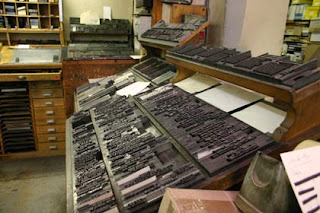Graphic Arts are a very large range of art forms, which includes photography, drawing, painting, printmaking, lithography, serigraphy (silk-screen printing), and bindery. It also is interior and architectural designs. Most commercial art can be called and is graphic art used to increase business. There are many different kinds of printing that are used in order to get the best results for different kinds of graphic art. There are many different types of graphic arts printing.
Graphic Arts Printing
Monday, January 3, 2011
Screen Printing
This type of printing involves the technique that uses a woven mesh to reinforce an ink-blocking stencil. The screen is constructed with a piece of absorbent woven fabric which is called mesh, which is stretched over the frame. This stencil then forms an open area of mesh which transfers ink on a printable material. This can then be pressed through the mesh as a sharp-edged image onto a substrate. A squeegee or rubber blade is then moved across the screen stencil, which forces the ink past the threads of the mesh in open areas.
There are three common types of screen printing presses.
Screen printing is very versatile. It is most often used to create t-shirts, but many different items can be designed with one such as a cloth bag. Plastic and metal can even be used. Small and intricate details can be captured, but its better suited for much bolder designs.
There are three common types of screen printing presses.
- flat-bed
- cylinder
- rotary (most common)
Screen printing is very versatile. It is most often used to create t-shirts, but many different items can be designed with one such as a cloth bag. Plastic and metal can even be used. Small and intricate details can be captured, but its better suited for much bolder designs.
Offset Lithography
This is the most common type of printing in the industry. It saves on ink and time, therefore it's much more affordable and cost effective for each print job. The inked image is put (or offset) from a plate to a rubber blanket and then finally to a printing surface. When this process is used with the combination of the lithographic process (based on oil and water), the offset technique involves a level image carrier on which the image to be printed gets ink from ink rollers. The non-printing area draws in a water-based film which keeps the non-printing areas ink-free.
Digital Printing
This is by far one of the most effective printing techniques as it reduces the time to complete the printing process. It directly transfers the digital file to the printing press. Most smaller jobs from desktop publishing and digital sources use this type of printing. Although it cost a bit more per page to print it also avoids many complicated technical steps in the printing process. Savings in labor along with many other advantages are making digital printing will soon be the absolute best way to produce larger prints.
Inkjet printers use dye based inks which can be applied to many different types of media including smooth or very textured surfaces. This type of digital printing is mainly known as Digigraph or Giclee printing.
Inkjet printers use dye based inks which can be applied to many different types of media including smooth or very textured surfaces. This type of digital printing is mainly known as Digigraph or Giclee printing.
Letterpress
This is one of the very first printing methods of all time. Letterpress printing is a type of relief printing where image and text using a press with a "type-high bed" printing press and type that is movable. The reversed and raised surface is inked and pressed into a sheet of paper to get a positive image. Rotary letterpresses were often used for high-speed work. These types of letterpresses used the invention of ultra-violet curing inks, which helped in areas like self-adhesive labels. This type of printing was the primary type of printing for over 500 years and although no longer used much today it continues to live on for certain commercial applications.
Electrostatic Printing
This method of printing is very similar to photocopying and it is what lead to the digital printing technology. It uses the method of attaching color to a drum and is blended with the paper with heat. It is also very cost effective in production. It is a process of printing without real contact. The paper is coated with a very thin layer of zinc oxide, which makes it an insulator while in the dark and a conductor of electricity when exposed to light. This paper is given a negative electrical charge in the dark.
Subscribe to:
Comments (Atom)





